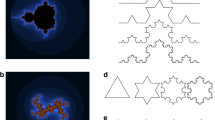Abstract
The purposes of our studies are to examine whether or not fractal-feature distance deduced from virtual volume method can simulate observer performance indices and to investigate the physical meaning of pseudo fractal dimension and complexity. Contrast-detail (C-D) phantom radiographs were obtained at various mAs values (0.5-4.0 mAs) and 140 kVp with a computed radiography system, and the reference image was acquired at 13 mAs. For all C-D images, fractal analysis was conducted using the virtual volume method that was devised with a fractional Brownian motion model. The fractal-feature distances between the considered and reference images were calculated using pseudo fractal dimension and complexity. Further, we have performed the C-D analysis in which ten radiologists participated, and compared the fractal-feature distances with the image quality figures (IQF). To clarify the physical meaning of the pseudo fractal dimension and complexity, contrast-to-noise ratio (CNR) and standard deviation (SD) of images noise were calculated for each mAs and compared with the pseudo fractal dimension and complexity, respectively. A strong linear correlation was found between the fractal-feature distance and IQF. The pseudo fractal dimensions became large as CNR increased. Further, a linear correlation was found between the exponential complexity and image noise SD.
Similar content being viewed by others
References
Rapp-Bemhardt, U, Roehl, F.W., Gibbs, R.C., Schmidl, H., Krause, U.W. and Bernhardt, T.M.,Flat-panel x-ray detector based on amorphous silicon versus asymmetric screen-film system: phantom study of dose reduction and depiction of simulated findings, Radiology 227, 484–492, 2003.
Strotzer, M., Völk, M., Frund, R., Hamer, O., Zorger, N. and Feuerbach, S.,Routine chest radiography using a flat-panel detector: image quality at standard detector dose and 33% dose reduction, Am. J. Roentgenol. 178, 169–171, 2002.
van Heesewijk, H. P. M., van der Graaf, Y., de Valois, J. C. and M. Feldberg, M. A.,Effects of dose reduction on digital chest imaging using a selenium detector: a study of detecting simulated diffuse interstitial pulmonary disease, Am. J. Roentgenol. 167, 403–408, 1996.
Völk, M., Hamer, O.W., Feuerbach, S. and Strotzer, M.,Dose reduction in skeletal and chest radiography using a large-area flat-panel detector based on amorphous silicon and thallium-doped cesium iodide: technical background, basic image quality parameters, and review of the literature, Eur. Radiol. 14, 827–834, 2004.
Chotas, H.G., Floyd, Jr. CE., Dobbins, 3rd J.T. and Ravin, C.E.,Digital chest radiography with photostimulable storage phosphors: signal-to-noise ratio as a function of kilovoltage with matched exposure risk, Radiology 186, 395–398, 1993.
Schaefer, CM., Greene, R., Llewellyn, HJ., Mrose, H.E., Pile-Spellman, E.A., Rubens, J.R. and Lindemann, S.R.,Interstitial lung disease: impact of postprocessing in digital storage phosphor imaging, Radiology 178, 733–738, 1991.
Sund, P., Båth, M., Kheddache, S. and Månsson, L.G.,Comparison of visual grading analysis and determination of detective quantum efficiency for evaluating system performance in digital chest radiography, Eur. Radiol. 14, 48–58, 2004.
Hillen, W., Schiebel, U. and Zaengel, T.,Imaging performance of a digital storage phosphor system. Med. Phys. 14(1987)744–751.
Strotzer, M., Völk, M., Wild, T., von Landenberg, P. and Feuerbach, S.,Simulated bone erosions in a hand phantom: detection with conventional screen-film technology versus cesium iodide-amorphous silicon flat-panel detector, Radiology 215, 512–515, 2000.
Fischbach, F., Ricke, J., Freund, T., Werk, M., Spors, B., Clemens, B., Maciej, P. and Roland, F.,Flat panel digital radiography compared with storage phosphor computed radiography: assessment of dose versus image quality in phantom studies, Invest. Radiol. 37, 609–614, 2002.
Suryanarayanan, S., Karellas, A., Vedantham, S., Ved, H., Baker, S.P. and D’Orsi, C.J.,Flat-panel digital mammography system: contrast-detail comparison between screen-film radiographs and hard-copy images, Radiology 225, 801–807, 2002.
Bacher, K., Smeets, P., Bonnarens, K., De Hauwere, A., Verstraete, K. and Thierens, H.,Dose reduction in patients undergoing chest imaging: digital amorphous silicon flatpanel detector radiography versus conventional film-screen radiography and phosphor-based computed radiography, Am. J. Roentgenol. 181, 923–929, 2003.
Hanley, J.A. and McNeil, B.J.,The meaning and use of the area under a receiver operating characteristic (ROC) curve, Radiology 143, 29–36, 1982.
Thyssen, M.A., Thyssen, H.O., Merx, J.L. and van Woensel, M.P.,Quality analysis of DSA equipment, Neuroradiology 30. 561–568, 1988.
Imai, K., Ikeda, M., Enchi, Y. and Niimi, T.,Fractal-feature distance analysis of radiographic image, Acad. Radiol. 14, 137–143, 2007.
Pentland, A.P.,Fractal-based description of natural scenes. IEEE T Pattern Anal PAMI-6, 661–674, 1984.
Tourassi, G.D., Delong, D.M. and Floyd, Jr. C.E.,A study on computerized fractal analysis of architectural distortion in screening mammograms, Phys. Med. Biol. 51, 1299–1312, 2006.
Mochizuki, T., Fujii, M. and Itoh, T.,Image retrieval using a new fractal feature and robust structural information (in Japanese). ITE 57, 719–728, 2003.
Imai, K., Ikeda, M. and Niimi, T.,The application of Markov theory to contrast-detail analysis. Acad. Radiol. 13, 152–158, 2006.
Author information
Authors and Affiliations
Corresponding author
Rights and permissions
About this article
Cite this article
Imai, K., Ikeda, M., Enchi, Y. et al. Fractal-feature distance analysis of contrast-detail phantom image and meaning of pseudo fractal dimension and complexity. Australas. Phys. Eng. Sci. Med. 32, 188–195 (2009). https://doi.org/10.1007/BF03179238
Received:
Accepted:
Issue Date:
DOI: https://doi.org/10.1007/BF03179238




